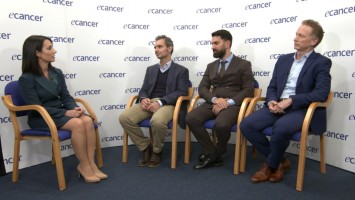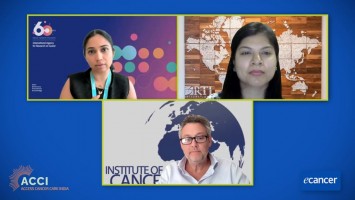ESMO ‘18 has been a great conference for breast cancer. We had several important news and one presidential session dedicated only to breast cancer. I will give some highlights on some important research, both in the early setting first and then move to the metastatic setting.
There are two major topics to be discussed for the early setting, one is the topic of adjuvant endocrine therapy in premenopausal women with hormone receptor positive breast cancer. We had a presentation for the first time of the results of the HOBOE trial, a randomised trial including more than 1,000 premenopausal women that were randomised to receive ovarian function suppression plus tamoxifen or a combination of letrozole and zoledronic acid. This study concluded that letrozole, so an aromatase inhibitor, appear to be superior to tamoxifen even though not statistically significant. The most interesting finding was that the addition of zoledronic acid on the top of letrozole significantly improved disease free survival with an 8% benefit at five years in disease free survival.
On the same topic the French investigators presented the first results of the CANTO study. This is a prospective study that wanted to assess after one year of tamoxifen therapy in premenopausal women how many of them were actually taking the medication. This is very important because we know that treatment adherence in young women is lower because of several reasons, including fertility and pregnancy related issues. This is the first time that we had this information objectively collected in the blood of the patients with a measurement of the tamoxifen level in the blood and what the investigators observed is that more than 15% of young women with breast cancer actually do not take adjuvant endocrine therapy as they would be supposed to do and the risk of being non-adherent is higher for women that do not receive prior chemotherapy.
Then in the early setting the other important news is related to the use of shorter trastuzumab duration, so 6 months, or even less, as compared to the standard one year duration. Here we had a presentation of two important sub-analyses of the shortHER trial recently published in the Annals of Oncology. Here the shortHER investigators presented a TIL, tumour infiltrating lymphocyte, analysis and a subgroup analysis looking at the efficacy of the trastuzumab duration according to baseline patient characteristics. The main take home message from these two presentations is that having high TILS is associated with a better prognosis and also these women may benefit from a shorter duration of adjuvant trastuzumab, as well as patients that have small tumours, less than 2cm, and node negative tumour. So a conclusion in the same line as the meta-analysis recently published in Breast Cancer Research and Treatment by Bishal Gyawali and colleagues showing the same, that one year overall is the best option but for patients at low risk of disease recurrence a shorter duration may be considered.
Moving to the metastatic setting, this is where we got the most important news for breast cancer patients. We had four important presentations during the first plenary session. The presentation that everybody was waiting for is the IMpassion trial, the first phase III trial with the use of immunotherapy in triple negative breast cancer. In this trial 900 triple negative breast cancer patients were randomised to first line nab-paclitaxel alone versus nab-paclitaxel plus PD-L1 inhibitor atezolizumab. The trial showed that although the PFS result was significantly positive towards the atezolizumab, for the atezolizumab arm, this was not really very exciting data, it was less than 2 months PFS benefit in the overall population, it’s likely more than 2 months in the PD-L1 positive population. But the most interesting finding is the fact that the overall survival of PD-L1 positive patients with the use of immunotherapy improved over 10 months, that is something that we have probably never seen in the field of triple negative breast cancer.
The last three presentations of the presidential are on the same topic – the use of endocrine therapy plus targeted therapy in patients with endocrine resistant advanced breast cancer. The first study is the PALOMA-3, fulvestrant and palbociclib versus fulvestrant. Here the investigators presented the overall survival data showing a 7 month absolute improvement in overall survival, not statistically significant but clinically very relevant. The second trial is the SOLAR-1 that investigated alpelisib plus fulvestrant versus fulvestrant alone in PIK3CA mutated or PIK3CA not mutated patients. The take home message is that these drugs work very well only for the PIK3CA mutated cohort with almost more than 5 months absolute improvement in progression free survival in this specific patient population.
Finally the results of a Chinese study on the use of a histone deacetylase inhibitor, chidamide, in association with exemestane versus exemestane alone. Again interesting findings – almost 4 months absolute improvement in progression free survival – but I think a trial that should be also performed and confirmed in the Western population.
The CDK4/6 inhibitor plus endocrine therapy has now become the standard treatment approach for patients with luminal advanced breast cancer. We had in the last year several important studies in both the endocrine sensitive setting as well as in the endocrine resistant setting. In both settings the addition of these agents to endocrine therapy is associated with significant improvement in progression free survival and now we start to have some data also on the benefit in overall survival. Here at ESMO we also had a presentation of quality of life data, so patient reported outcomes data, from this trial showing that even though adding the targeted agents increases the incidence of side effects still this is not associated with a worse quality of life and a worse performance in the patient reported outcomes analysis. So these are very important treatment options that we should now adopt in daily clinical practice.








